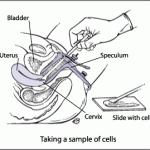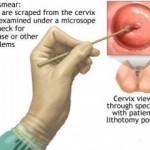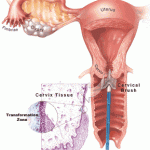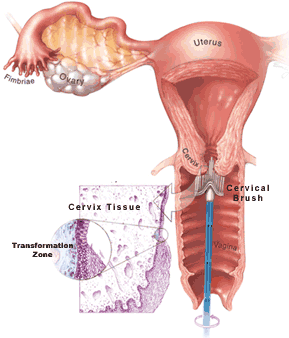The Pap test, also called a Pap smear or cervical cytology screening, checks for abnormal changes in the cells of the cervix and allows early treatment so that abnormal cells do not become cancer.
What causes abnormal Pap test results?
The main cause of abnormal Pap test results is infection with human papillomavirus (HPV). There are many types of HPV. Some types have been linked to cancer of the cervix, vulva, and vagina. Other types have been linked to genital warts.
 An ASCUS (ASC-US or ASC) Pap smear is the most common type of abnormal Pap smear result. ASCUS is an acronym for atypical cells of undetermined significance and indicates mild cellular cervical changes with an unknown cause. While an ASCUS Pap smear result may sound alarming, it is considered mildly abnormal. There is no immediate cervical cancer risk in an ASCUS Pap smear result.
An ASCUS (ASC-US or ASC) Pap smear is the most common type of abnormal Pap smear result. ASCUS is an acronym for atypical cells of undetermined significance and indicates mild cellular cervical changes with an unknown cause. While an ASCUS Pap smear result may sound alarming, it is considered mildly abnormal. There is no immediate cervical cancer risk in an ASCUS Pap smear result.
What is the Bethesda System?
The Bethesda System is a list of terms used by labs to describe Pap test results. With the Bethesda System, your Pap test results will be placed in one of several groups:
- Normal (negative)—There are no signs of cancer or precancer.
- Atypical squamous cells of undetermined significance (ASC-US)—Changes in the cervical cells have been found. The changes are almost always a sign of an HPV infection but may indicate precancer is present. ASC-US is the most common abnormal Pap test result.
- Squamous intraepithelial lesion (SIL)—Abnormal changes are seen in the cells that may be a sign of precancer. SIL can be low grade (LSIL) or high grade (HSIL).
- LSIL is mild or moderate dysplasia (CIN 1 and CIN 2). It almost always indicates that an HPV infection is present, but it also may indicate mild precancer changes. LSIL is very common and usually goes away on its own without treatment.
- HSIL is severe dysplasia, either CIN 3 or carcinoma in situ (CIS). This result is most likely to progress to cancer.
- Atypical squamous cells, cannot exclude HSIL (ASC-H)—Changes in the cervical cells have been found. These changes are not clearly HSIL but could be. Further testing is needed.
- Atypical glandular cells (AGC)—Cell changes are seen that suggest precancer of the upper part of the cervix or uterus.
- Cancer—Abnormal cells may have spread deeper into the cervix or to other tissues.
What is the difference between the terms dysplasia, cervical intraepithelial neoplasia (CIN), and squamous intraepithelial lesion (SIL)?
 All of these terms are used to describe precancer changes in the cervix that occur as a result of HPV infection, but they are used in different situations.
All of these terms are used to describe precancer changes in the cervix that occur as a result of HPV infection, but they are used in different situations.
Dysplasia and cervical intraepithelial neoplasia (CIN) describe the actual changes that occur in the cervix. Dysplasia and CIN are graded as mild, moderate, or severe. Mild dysplasia (CIN 1) usually goes away on its own. Moderate (CIN 2) and severe (CIN 3) dysplasia indicate more serious changes.
The term squamous intraepithelial lesion is used by the Bethesda System for abnormal growth of cells on the surface of the cervix. “Squamous” refers to the type of cells that make up the tissue that covers the cervix.
The Causes of ASCUS Pap Smear Results
A common cause of ASCUS Pap smears are minor infection and cervical inflammation. Infection and inflammation can cause cervical cells to appear abnormal, but eventually return to a normal appearance.
For some women, an ASCUS result is due to changes in the cervical cells caused by HPV infection. In most cases, these cervical changes do not progress to cervical cancer, but require further monitoring and possible treatment to prevent cervical cancer.
 Rarely, invasive cervical cancer may be detected through further examination and testing.
Rarely, invasive cervical cancer may be detected through further examination and testing.
For adolescents and young women, ASCUS Pap smear results are as often or more often caused by HPV infection than a vaginal infection or cervical inflammation. In older women, ASCUS results are more often because of vaginal infection or cervical inflammation, not an infection of HPV.
Managing an ASCUS Pap Smear Result
The method in which a doctor manages an ASCUS pap smear result varies. New guidelines set forth by American Society for Colposcopy and Cervical Pathology (ASCCP) recommend:
Adolescent Women (age 20 and younger):Â For young women with an ASCUS Pap smear result, the test is repeated in 12 months.
Adult Women:Â Adult women with an ASCUS Pap result will either have the Pap test repeated at 6 and 12 months or have a reflexive HPV DNA test. A reflexive HPV DNA test utilizes the sample used for the Pap smear and eliminates the need for another sampling. ASCCP guidelines favor HPV DNA testing for adult women with ASCUS Pap results.
An HPV DNA test is performed just like a Pap smear. The test detects the presence of a high risk HPV infection that could potentially lead to cervical pre-cancer or cancer if left unmonitored or untreated.
